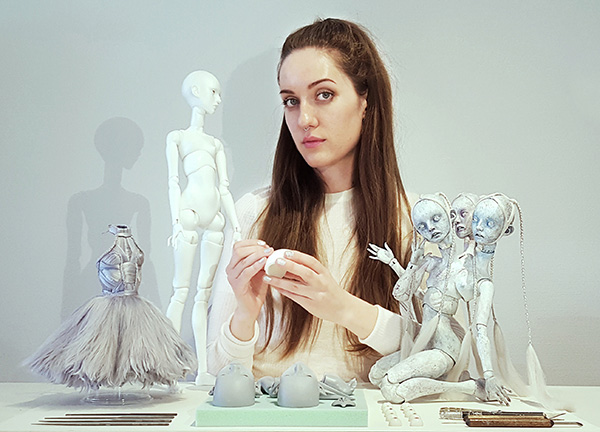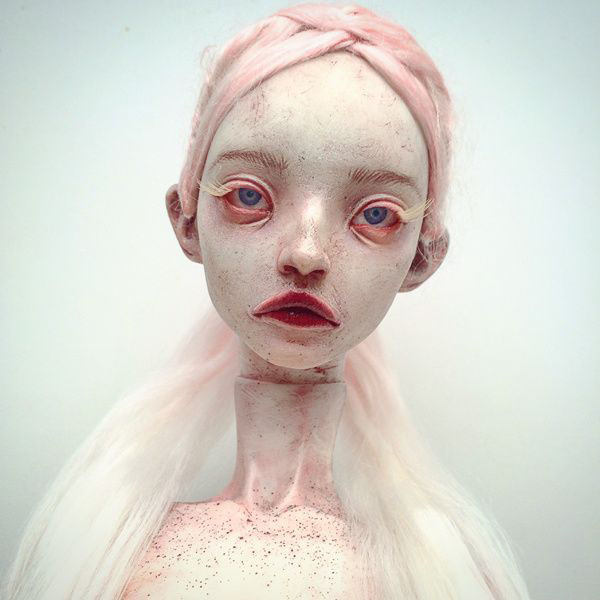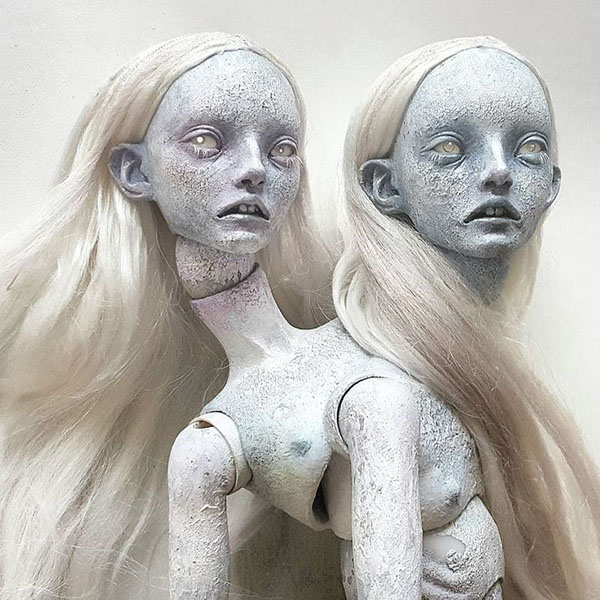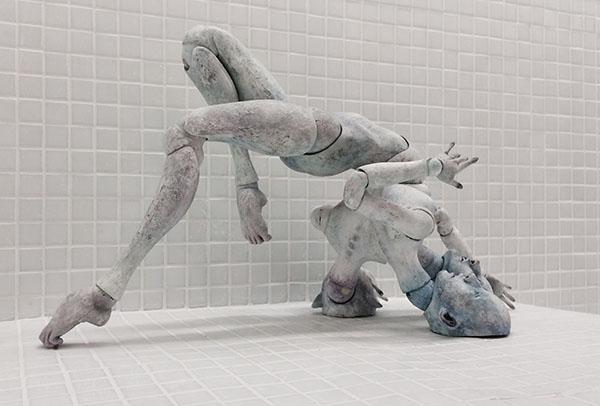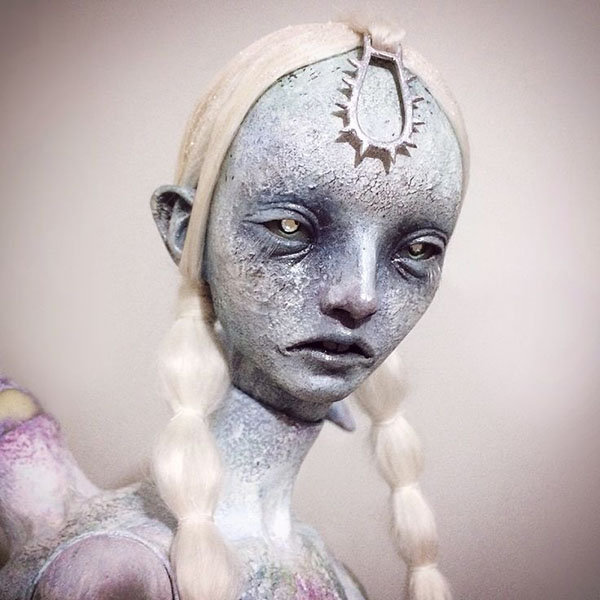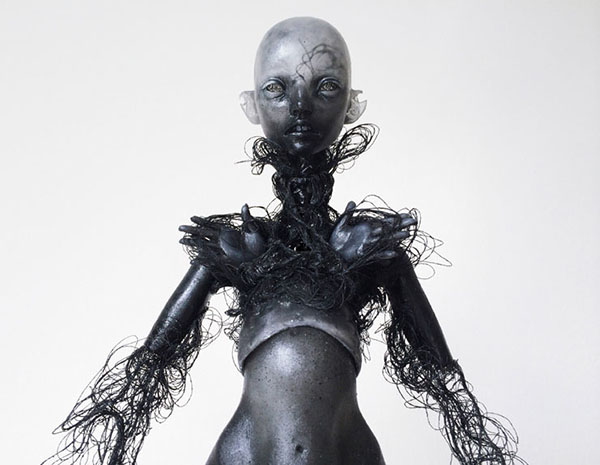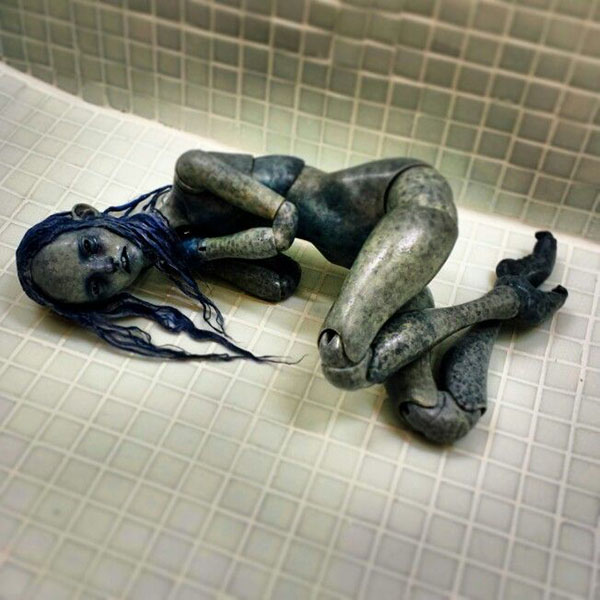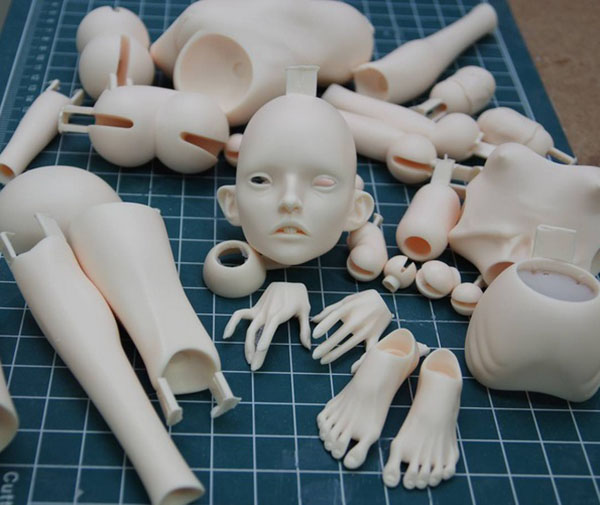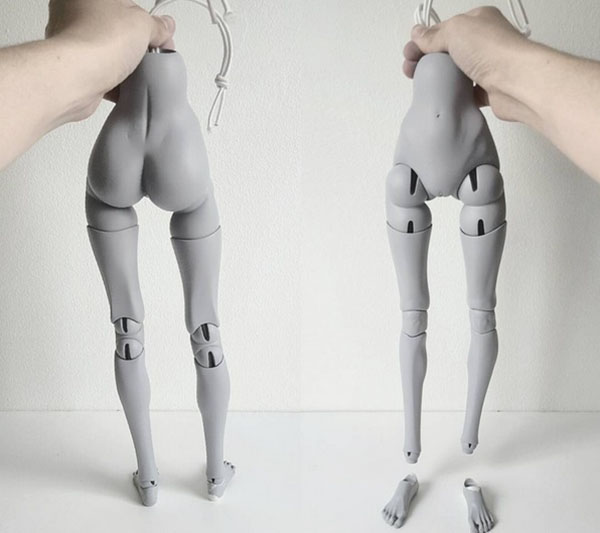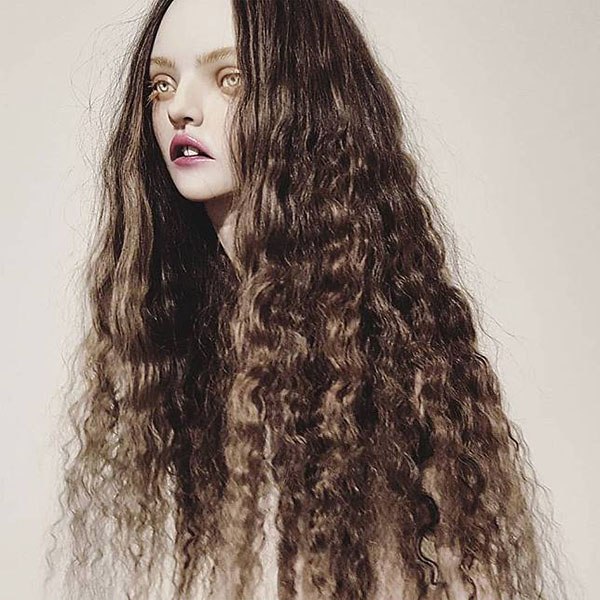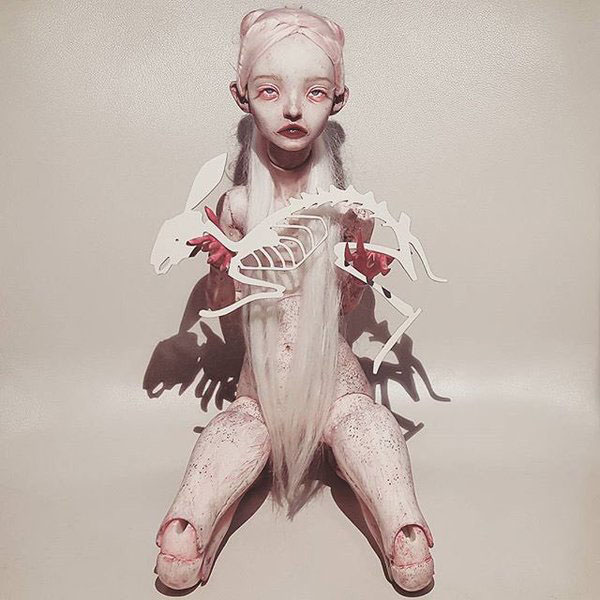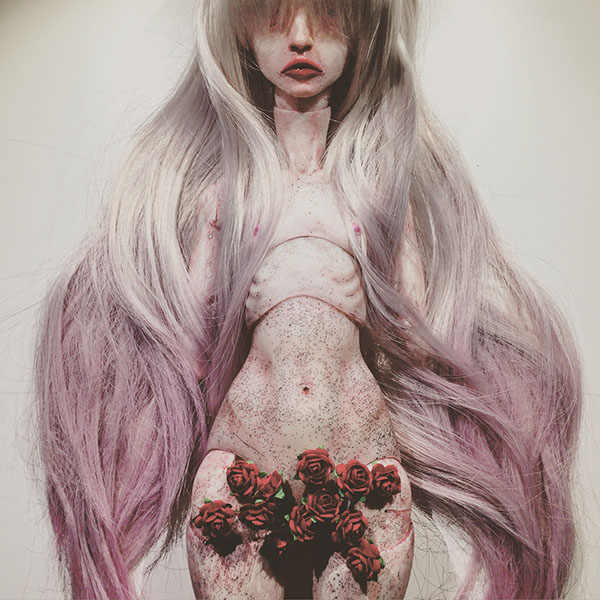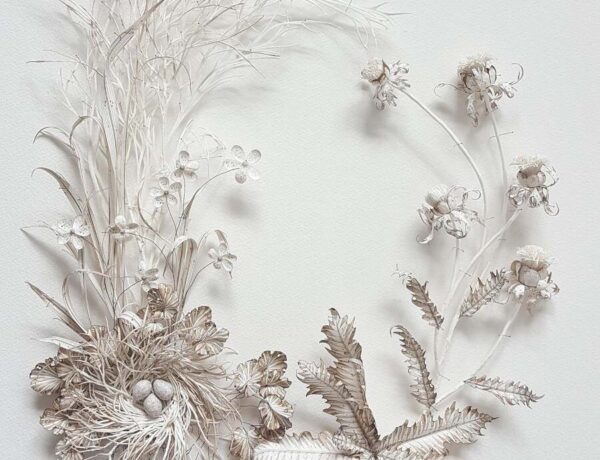From prehistoric Venus figurines to film depictions of Artificial Intelligence like the silent, but haunting, Metropolis, it is no secret that humans adore to recreate depictions of themselves. And Emilie Steeles’ enrapturing beauties are no different. At first glance they may be visually stunning, but on closer encounter they are, as Emilie intended, creatures that refuse definition. These dolls are not playthings, they are psyche mirrors. Emilie was kind enough to sit with us for an interview in Beautiful Bizarre Magazine Issue 017. Illuminating us on her incredible process, conceptually and physically, we got an in-depth perspective on Emilie’s beautiful hand-made dolls.
What was your childhood like, and what experiences do you think helped shape the artist you are today? Can you remember what sparked your initial artistic interest and aesthetic?
I grew up as the middle child with my two sisters and our parents outside of Stockholm, Sweden, living in a tiny house located on a hilltop facing an inlet in the Baltic Sea, surrounded by forest and infinite skies. Sweden is a cold and dark place a large part of the year, except during the brief summers when the sun only sets for a few hours before re-rising. These changing seasons and somewhat isolated surroundings left me with an impression of melancholy and a sense of longing – aspects that echo through my current expression it seems.
Disney films, Japanese anime and Stop-motion animation made a big impact and influenced me from early on as I watched animated films daily, I would repeatedly pause the screen to be able to study the characters in frozen moments. The pen became my extended body the very moment I was introduced to it and I developed the urge to create images and tell stories of my own at a tender age – I thank my parents for that. They inspired and provided their daughters with the tools and materials needed in order to learn artistic skills, and in addition, they both shared their vivid imaginations by telling us improvised tales about heroines and otherworldly creatures.
Much of your work uses the female body as a canvas with your illustrations, and especially with your beautifully detailed dolls. Why do you think the female body lends itself so well to inspiration and creation? What about femininity inspires you? How do you feel about women’s role in society and the expectations she is born into? How does this translate into your art?
My work is a way for me to interpret my surroundings and since I’m interested in human and bodily experience – and the image of it – I’ve chosen to work with figurative bodies. When translating my experiences of the world into craftsmanship, the familiar female form in particular comes naturally, seeing that I identify as a woman myself.
Modern women are liberated from many of the chains worn by previous generations, yet countless free female bodies are finding new restrains by becoming synthetic, both physically and via our digital alter egos, in attempts to conform to social norms and ideals. “Degrees of Freedom” can be used as a term to describe a doll’s joints and their capability for movement. As my figures possess high “degrees of freedom” their state of captivity and dysfunction are enhanced, as they exist in a type of suspension. I want to depict a longing to be human and to unapologetically express universal yet socially unaccepted traits. Displaying constructed dolls can remind us that we, ourselves, are artificial and constructed. Casting identical dolls from the same mold also makes contradicting attributes possible within the same character. The image of femininity often seems simplified, and rather than contributing to a one-sided stereotype, I aim to portray versatile, multi-layered women who resist definition.
Many of your dolls look as though they could be a character from a Hans Christian Anderson or Grimm’s fairy tales. Does folklore lend a hand to your process and what is it about beauty melded with darkness, like in The Red Shoes, that people find so magnetic?
The fictive worlds of both folklore and modern fairy tales have always been, and still are, major inspirations! When working on a doll I usually think of it as being part of a narrative with its own agenda, and this can help me develop the piece.
I consider beauty and seductiveness as a powerful tool, especially collided with the topic of darkness. Darkness, the mystical and the unknown, are commonly considered as dangerous merely because these are undefined. The conception of danger is known to awake strong emotion and can even be entertaining when experienced from a distance, but with today’s constant exposure of cruelty one might become jaded and develop a blind spot. By beautifying an argument through embellished rhetoric, or via pleasant visual aspects, an audience can be receptive to subjects that were originally too heavy to bear. Furthermore, darkness seems more honest to me. After all, doesn’t our dark sky only appear to be blue because of earth’s very own facade, the atmosphere?
That’s a lovely point. Tell us more about what is your process like. Do you start with image research, sketches or the like, and how does one go from an idea to a completed doll? How long does it take to complete your vision for one of your lovely creatures?
My process differs completely from one piece to another. I am a constant researcher, not only with specific projects in mind, always a camera ready in hand to capture interesting structures and color palettes, listening to books or music while I work with my hands, consuming images, and eager to learn new techniques and finding new materials. I want the work to develop within the actual making like an open-minded conversation, not simply fabricating a plan, so I don’t make sketches beforehand that often, due to my tendencies to turn into a problem solver. I do however like to make mood boards, as a sort of holistic theme sketch. I’ve been called “the machine” in the past because of how fast I could produce new works, but now the aspect of slowness, as in letting the work develop over a (preferably long) period of time, is important to me. I work simultaneously on different pieces to stay focused and to allow reflection trough distance from the works.
It takes more than one year to sculpt a new clay body, and the time it takes to complete each unique piece differs but usually they grow over a period of six months to two years. One of the main reasons I’m making these kind of poseable sculptures though, is because of the fact that the outcome is not locked or static, a doll has the ability to continue to become beyond what it was and is never really finished.
It is no wonder you have a background in fashion design. Every detail of your incredible body of work has a very high fashion curated and editorial feel. What took you from an undergrad in Fashion Design to metal working at Nyckelviksskolan to an MFA? What drew you to doll making? What fuels your creativity the most/most often?
I decided to study fashion design with the longing to work with the body as a base and to transform the wearer’s identity through shape and material, but quite early during my studies, I felt my inner spark fade, and I realized that commercial fashion design was not for me. I felt limited being bound to something already existing such as the human body and I wasn’t able to express the subject matters I wanted to convey. After graduating, I wanted to retrieve my lost creative appetite and somehow yearned to work with the foundation of material, rather than just adding to a surface like on a canvas or a body. Leaving the result-focused thinking behind I threw myself into the – to me – unfamiliar field of metal arts with a new focus on playfulness, exploring materials and ways of making. While there, I was introduced to casting techniques among other things, which triggered an eagerness for further development.
The first contact that I can recall of dolls used in a different context than the world of toys and stop-motion film, was photographs in a design magazine of the ambiguous dolls created by German artist Hans Bellmer. Since this discovery in my late teens, dolls as a medium has been even more captivating to me. My curiosity for representation and construction has been a red thread over the years, and when reevaluating what fueled my fire it became obvious that I would start making dolls.
My central driving force is a passion for learning new things and the love of making with my hands, to entertain several senses at once. I always felt torn before, unable to explore the many subjects, techniques and materials that fascinated me. Doll making allows me to combine all the things that interest me into one artistic practice.
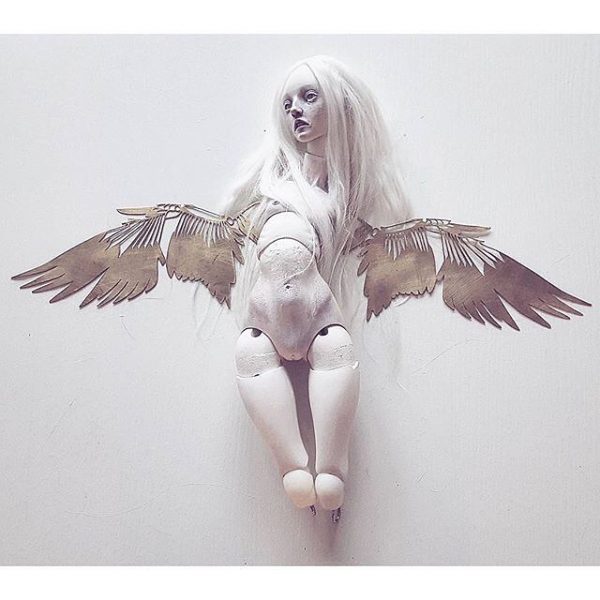 One of your dolls was recently in the Guillermo del Toro show at LACMA. How did it feel to be a part of this exhibit and what would you like people to think about or take away with them after viewing your work? Is it hard letting them go when people buy them or want them for exhibits?
One of your dolls was recently in the Guillermo del Toro show at LACMA. How did it feel to be a part of this exhibit and what would you like people to think about or take away with them after viewing your work? Is it hard letting them go when people buy them or want them for exhibits?
When del Toro contacted me about inquiring the piece I honestly thought I was being pranked, as the people who know me are well aware of my admiration for him and his work, and I didn’t quite believe it to be true until I saw actual photos of the doll participating in his exhibition. This made me feel incredibly fortunate and like anything is possible really! My thoughts about sharing inspiration certainly harmonize with this particular exhibition as well, it’s very generous to make such a collection accessible to the public.
I highly value my handcraft and many tactile aspects don’t translate fairly via photographs in my opinion. Most of my pieces are initially intended to be experienced up close in the same room as the audience. I like to create perplex pieces that are perceived in one way from afar only to become something else up close. They are quite small and very detailed and this can hopefully generate a certain intimacy between the viewer and the object. I hope that people find themselves questioning their own reaction to my work as well as their preconceived opinions. If it contributes to a conversation or simply spark any form of imagination I’m more than happy.
I’m very glad to let go of my pieces and see them serve their intentional, or a new, purpose. It’s inevitable to sell works in order to continue making new work, and the joy it brings absolutely prevails over any kind of anxiety or attachment issue that might occur. This also literally creates much needed empty space for new works to fill!
What do you hope to create in the future? Are there any artists you hope to collaborate with? Will we ever see your dolls in a stop motion film format? Are there any shows coming up that you would like to tell our readers about?
At the moment I’m in the process of creating new pieces toward up-coming exhibitions. I’m also continuing to develop current projects as well as working with a wider range of materials and making new bodies, male as well as unspecified genders, and I very much look forward to approach new subjects and I hope not to end up in some kind of comfort zone.
Photographic series are on the horizon, and to make film has been a lifelong dream of mine! In 2015 I was part of a collaborative project where we began to make a stop-motion music video which included my dolls, but we lacked time and resources at that point to finish it – so to be continued… I’ve been developing a number of different stories over several years now, and I would love to see at least one of those turn into a stop-motion animation.
I’m also thrilled about being part of these upcoming exhibitions; a group exhibition at Stoerpunk in Munich, July 6 – August 11 2017 as well as the Beautiful Bizarre Magazine’s curated group exhibition at Haven Gallery in New York, September 17 – October 17 2017.


